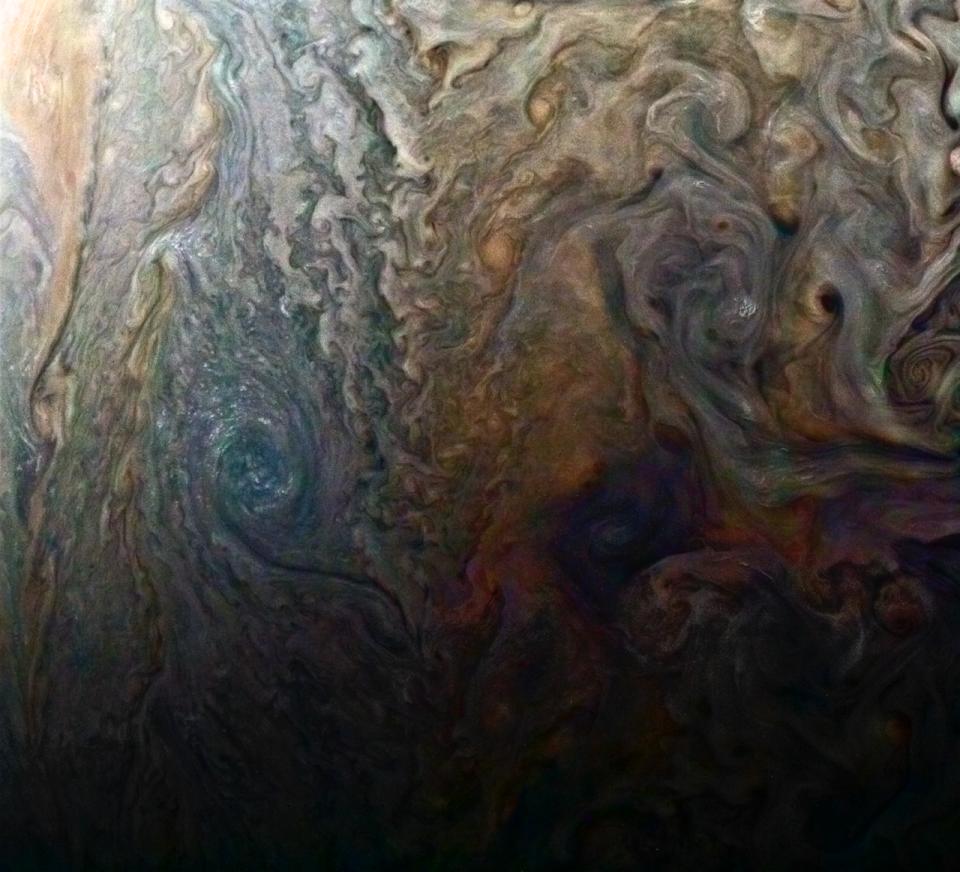03.24.17
Juno Spacecraft Completes Fifth Jupiter Flyby

This enhanced-color image of a mysterious dark spot on Jupiter
seems to reveal a Jovian “galaxy” of swirling storms.
Juno acquired this JunoCam image on Feb. 2, 2017, at 5:13 a.m. PDT (8:13 a.m. EDT), at an altitude of 9,000 miles (14,500 kilometers) above the giant planet’s cloud tops. This publicly selected target was simply titled “Dark Spot.” In ground-based images it was difficult to tell that it is a dark storm.
Citizen scientist Roman Tkachenko enhanced the color to bring out the rich detail in the storm and surrounding clouds. Just south of the dark storm is a bright, oval-shaped storm with high, bright, white clouds, reminiscent of a swirling galaxy. As a final touch, he rotated the image 90 degrees, turning the picture into a work of art.
Credits: NASA/JPL-Caltech/SwRI/MSSS/Roman Tkachenko
Juno acquired this JunoCam image on Feb. 2, 2017, at 5:13 a.m. PDT (8:13 a.m. EDT), at an altitude of 9,000 miles (14,500 kilometers) above the giant planet’s cloud tops. This publicly selected target was simply titled “Dark Spot.” In ground-based images it was difficult to tell that it is a dark storm.
Citizen scientist Roman Tkachenko enhanced the color to bring out the rich detail in the storm and surrounding clouds. Just south of the dark storm is a bright, oval-shaped storm with high, bright, white clouds, reminiscent of a swirling galaxy. As a final touch, he rotated the image 90 degrees, turning the picture into a work of art.
Credits: NASA/JPL-Caltech/SwRI/MSSS/Roman Tkachenko
Updated March 27, 2017 at 1:45 p.m. PDT
NASA's Juno mission accomplished a close flyby of Jupiter on Monday, March 27, successfully completing its fourth science orbit.
All of Juno's science instruments and the spacecraft's JunoCam were operating during the flyby, collecting data that is now being returned to Earth. Juno’s next close flyby of Jupiter will occur on May 19, 2017.
---
Original Post:
NASA's Juno spacecraft will make its fifth flyby over Jupiter's mysterious cloud tops on Monday, March 27, at 1:52 a.m. PDT (4:52 a.m. EDT, 8:52 UTC).
At the time of closest approach (called perijove), Juno will be about 2,700 miles (4,400 kilometers) above the planet's cloud tops, traveling at a speed of about 129,000 miles per hour (57.8 kilometers per second) relative to the gas-giant planet. All of Juno's eight science instruments will be on and collecting data during the flyby.
"This will be our fourth science pass -- the fifth close flyby of Jupiter of the mission -- and we are excited to see what new discoveries Juno will reveal,” said Scott Bolton, principal investigator of Juno from the Southwest Research Institute in San Antonio. "Every time we get near Jupiter’s cloud tops, we learn new insights that help us understand this amazing giant planet."
The Juno science team continues to analyze returns from previous flybys. Scientists have discovered that Jupiter's magnetic fields are more complicated than originally thought, and that the belts and zones that give the planet's cloud tops their distinctive look extend deep into the its interior. Observations of the energetic particles that create the incandescent auroras suggest a complicated current system involving charged material lofted from volcanoes on Jupiter's moon Io.
Peer-reviewed papers with more in-depth science results from Juno's first flybys are expected to be published within the next few months.
Juno launched on Aug. 5, 2011, from Cape Canaveral, Florida, and arrived in orbit around Jupiter on July 4, 2016. During its mission of exploration, Juno soars low over the planet's cloud tops -- as close as about 2,600 miles (4,100 kilometers). During these flybys, Juno is probing beneath the obscuring cloud cover of Jupiter and studying its auroras to learn more about the planet's origins, structure, atmosphere and magnetosphere.
NASA's Juno mission accomplished a close flyby of Jupiter on Monday, March 27, successfully completing its fourth science orbit.
All of Juno's science instruments and the spacecraft's JunoCam were operating during the flyby, collecting data that is now being returned to Earth. Juno’s next close flyby of Jupiter will occur on May 19, 2017.
---
Original Post:
NASA's Juno spacecraft will make its fifth flyby over Jupiter's mysterious cloud tops on Monday, March 27, at 1:52 a.m. PDT (4:52 a.m. EDT, 8:52 UTC).
At the time of closest approach (called perijove), Juno will be about 2,700 miles (4,400 kilometers) above the planet's cloud tops, traveling at a speed of about 129,000 miles per hour (57.8 kilometers per second) relative to the gas-giant planet. All of Juno's eight science instruments will be on and collecting data during the flyby.
"This will be our fourth science pass -- the fifth close flyby of Jupiter of the mission -- and we are excited to see what new discoveries Juno will reveal,” said Scott Bolton, principal investigator of Juno from the Southwest Research Institute in San Antonio. "Every time we get near Jupiter’s cloud tops, we learn new insights that help us understand this amazing giant planet."
The Juno science team continues to analyze returns from previous flybys. Scientists have discovered that Jupiter's magnetic fields are more complicated than originally thought, and that the belts and zones that give the planet's cloud tops their distinctive look extend deep into the its interior. Observations of the energetic particles that create the incandescent auroras suggest a complicated current system involving charged material lofted from volcanoes on Jupiter's moon Io.
Peer-reviewed papers with more in-depth science results from Juno's first flybys are expected to be published within the next few months.
Juno launched on Aug. 5, 2011, from Cape Canaveral, Florida, and arrived in orbit around Jupiter on July 4, 2016. During its mission of exploration, Juno soars low over the planet's cloud tops -- as close as about 2,600 miles (4,100 kilometers). During these flybys, Juno is probing beneath the obscuring cloud cover of Jupiter and studying its auroras to learn more about the planet's origins, structure, atmosphere and magnetosphere.